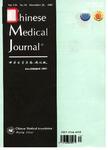Prevalence and characteristics of myocardial bridging in coronary angiogram data from consecutive 5525 patients
Prevalence and characteristics of myocardial bridging in coronary angiogram data from consecutive 5525 patients作者机构:Department of Cardiology Zhongshan Hospital Fudan University Shanghai Institute of Cardiovascular Diseases Shanghai 200032 China
出 版 物:《Chinese Medical Journal》 (中华医学杂志(英文版))
年 卷 期:2009年第122卷第6期
页 面:632-635页
核心收录:
学科分类:1002[医学-临床医学] 100201[医学-内科学(含:心血管病、血液病、呼吸系病、消化系病、内分泌与代谢病、肾病、风湿病、传染病)] 10[医学]
主 题:myocardial bridging coronary angiography prevalence nitroglycerine stent
摘 要:Background Large discrepancy of the incidence of myocardial bridging (MB) has been reported either among the postmortem studies or among the studies with coronary angiogram. This study was to investigate the prevalence of MB in large number of coronary angiograms and the angiographic characteristics of MB. Methods A total of 5525 consecutive patients who underwent first diagnostic coronary angiography from January 2003 to March 2006 in Zhongshan Hospital were enrolled in this study. MB was diagnosed when the angiographical "milking effect", defined as the systolic compression and complete or partly release of the compression in diastole, was seen in the epicardial coronary arteries. Angiography was routinely repeated after intracoronary injection of 200 pg nitroglycerin. The systolic compression and length of MB were compared before and after the administration of nitroglycerin and also before and after stent implantation in patients with significant stenosis in segment proximal to the MB. Results Among 5525 patients, MBs were found in a total of 888 patients angiographically with the prevalence of 16.1%. Atherosclerotic lesions were found more often in the segment proximal to the MB with 344/854 (40.3%) patients than in the segment distal to the MB with 47/854 (5.5%) (P 〈0.01). The systolic compression ((43.3±13.7)% at baseline vs (54.2±14.0)% after nitroglycerine) and the average length ((20.9±7.5) mm at baseline vs (22.7±8.0) mm after nitroglycerine) of the MB segment were increased after intracoronary injection of nitroglycerin (both P 〈0.01). Stent implantation was performed in 88 patients with significant stenosis in the segment proximal to the MB. The systolic compression and the length of the MB segment were increased after stenting compared with those before stenting (systolic compression, (49.4±14.6)% at baseline vs (57.3±12.3)% after stenting, and length of MB, (19.5±6.1) mm at baseline vs (21.8±6.3) mm after stenting, P 〈0.01). Conclusions MB was a fr



